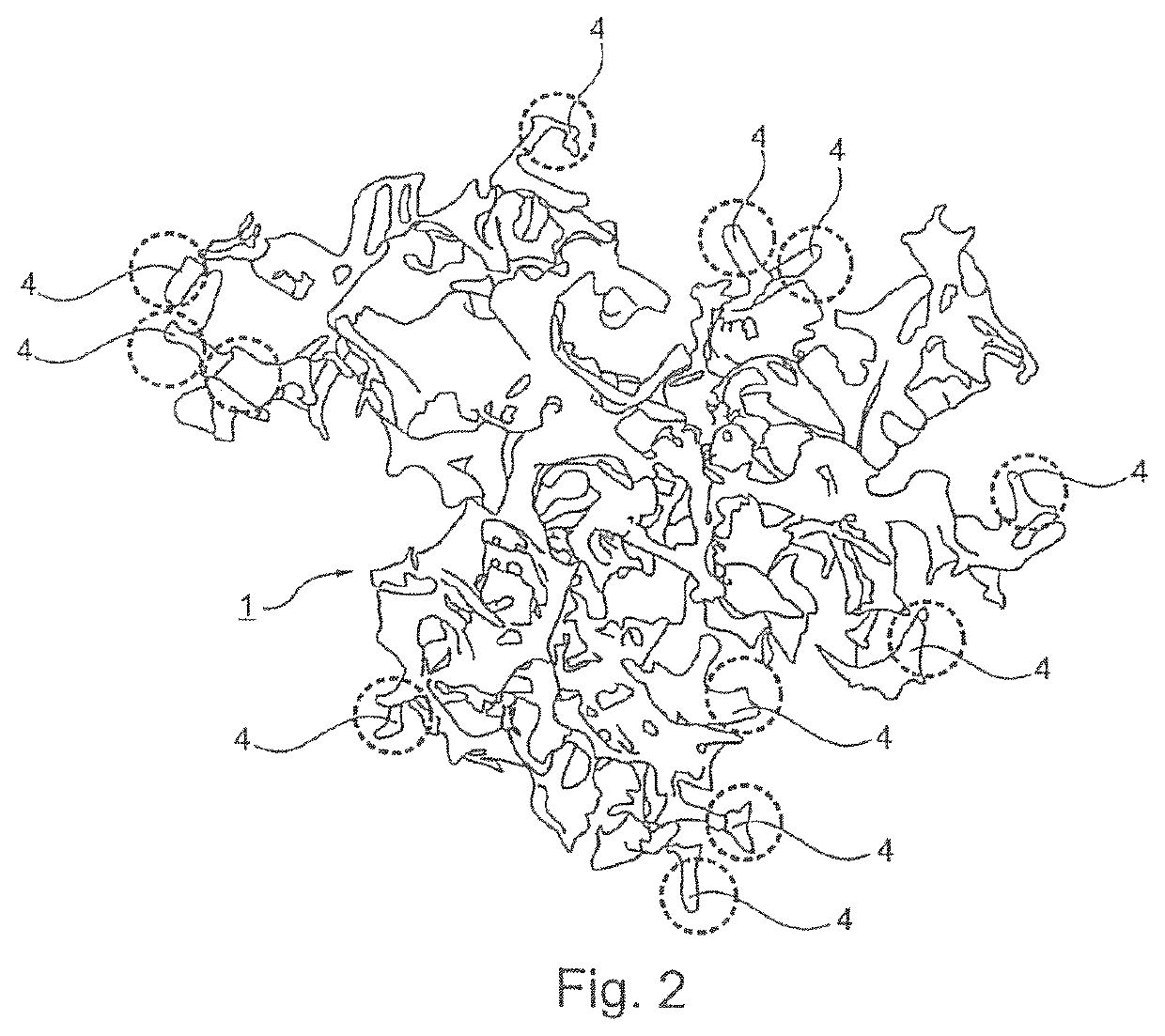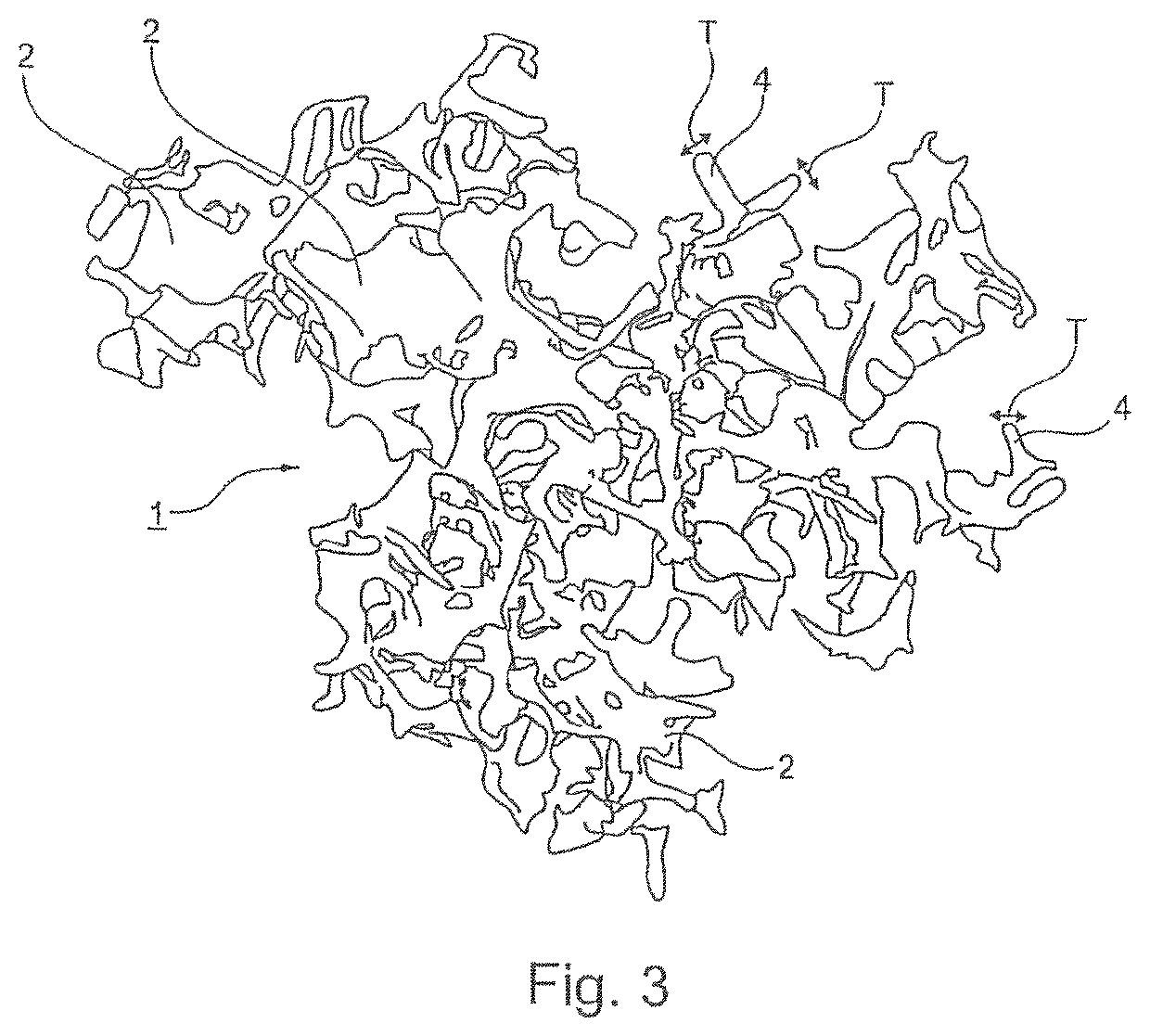Particle suitable for the manufacture of an implantable soft tissue engineering material
a technology of engineering materials and particles, applied in the field of particles suitable for the manufacture of implantable soft tissue engineering materials, can solve the problems of material not having the capacity to expand, hardness and elasticity of particles, reconstruction process, and inability to adjust, so as to increase the volume of particles and the effect of increasing the size of conduits
- Summary
- Abstract
- Description
- Claims
- Application Information
AI Technical Summary
Benefits of technology
Problems solved by technology
Method used
Image
Examples
example 1
[0153]Carboxymethyl-cellulose (with a MW of 700 kDa) was dissolved in deionized water to the concentration of 2%, and crosslinking initiated after precooling to 4° C. by means of addition of adipic acid dihydrazide AAD (0.07%) and a small excess of the carbodiimide EDC (0.4%) and buffered to a pH-value of 5.5. by means of an excess of 2-(N-morpholino)ethanesulfonic acid (MES) buffer (50 mM).
[0154]The reaction mixture was placed at −20° C. in a mold. After 1 day, the scaffolds were thawed and washed in de-ionized water (DI).
[0155]The next step consisted in fractioning the scaffold. For this, a bulk scaffold or a bulk scaffold piece was placed in a plastic bag and compressed and sheared manually to create the particles according to the invention. In another embodiment, the bulk scaffold was extruded through a thin tubular element by applying a known pressure to obtain a fragmented material.
[0156]The particle size was controlled by the pressure applied on the piston of the syringe and ...
example 2a
[0157]The same procedure as in example 1 was followed but prior to freezing, the reaction mixture was distributed into a silicone mold using a pipette of 10 mL. The silicone mold contained microstructured star-shaped cavities measuring 100 micrometers in diameter and 20 micrometers in depth. The silicone mold was covered with a flat polypropylene counterpart, squeezing excess liquid from the mold. The assembly was then placed into a freezer at −20° C.
[0158]Alternative Methods for the Manufacture of Particles:
[0159]Particles were manufactured by placing the scaffolds into a mixer and mixing them.
[0160]Particles were manufactured by ink-jet printing, 3D printing, and additive manufacturing.
[0161]Particles were manufactured by mixing the reaction mixture with a photosensitizer (typically acrylamide monomer and N,N′methylenebis(acrylamide), freezing at −20° C. and photopolymerizing using a UV lamp or a visible lamp.
[0162]Particles were manufactured by grinding a preliminary manufactured...
example 2b
[0165]A solution of 5% of hyaluronic acid monomers with a molecular weight of 90 kDa, MES buffer pH6, adipic acid dihydrazide (2 mg / mL) was mixed with EDC (4 mg / mL) and poured onto a consolidated paraffin microspheres scaffold. The paraffin beads were prepared according to “Microspheres leaching for scaffold porosity control”, Draghi et al, Journal of Material sciences: Materials in medicine, 16 (2005) 1993-1997. The mixture was incubated at room temperature during 24 hours after which the paraffin beads were dissolved by an excess of hexane. The obtained scaffold was then rinsed with isopropanol, and a mix of isopropanol and water (40%:60%) and followed by a rinsing step with water.
[0166]The obtained scaffold was then fragmented by applying an extrusion force on the scaffold through a narrow tubular element.
[0167]B) Manufacture of an Implantable Soft Tissue Engineering Material Comprising a Multitude of Particles According to the Invention
PUM
| Property | Measurement | Unit |
|---|---|---|
| Young's modulus | aaaaa | aaaaa |
| Young's modulus | aaaaa | aaaaa |
| mean diameter DC | aaaaa | aaaaa |
Abstract
Description
Claims
Application Information
 Login to View More
Login to View More - R&D
- Intellectual Property
- Life Sciences
- Materials
- Tech Scout
- Unparalleled Data Quality
- Higher Quality Content
- 60% Fewer Hallucinations
Browse by: Latest US Patents, China's latest patents, Technical Efficacy Thesaurus, Application Domain, Technology Topic, Popular Technical Reports.
© 2025 PatSnap. All rights reserved.Legal|Privacy policy|Modern Slavery Act Transparency Statement|Sitemap|About US| Contact US: help@patsnap.com



